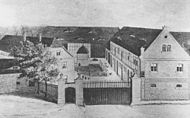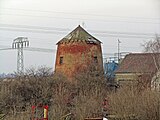Knautnaundorf
|
Knautnaundorf district of Leipzig |
|
|---|---|
| Coordinates | 51 ° 15 ′ 16 ″ N , 12 ° 16 ′ 16 ″ E |
| height | 123 m |
| Residents | 559 (1990) |
| Post Code | 04249 |
| prefix | 0341 |
| Borough | southwest |
| Transport links | |
| Highway |
|
| Federal road |
|
| bus | 63, 120 |
The place Knautnaundorf has been a district of Leipzig since its incorporation in 1999 . Since 2001, he is in the administrative division of Leipzig along with Hartmann village to village Hartmannsdorf-Knautnaundorf in the district southwest. Rehbach , which was incorporated in 1973, belongs to Knautnaundorf . Together with Knautkleeberg and Knauthain , the place belongs to the Knautdörfern .
Location and local characteristics
Knautnaundorf is located in the southwest of Leipzig about 12 kilometers from Leipzig city center. It borders Rehbach in the north and Hartmannsdorf in the northeast . Lake Zwenkau lies in the southeast . From south to west follow Zitzschen , the Pegau districts of Kleinschkorlopp, Großschkorlopp and Schkeitbar as well as Seebenisch, which belongs to Markranstädt . Before it was demolished by the Zwenkau opencast mine , Bösdorf and Eythra were still southeastern neighbors. Their areas were incorporated into Knautnaundorf in 1988.
Knautnaundorf is on a plain slightly above the Elsteraue . While the Elster was about three kilometers away from the place before it was laid by the lignite mining , it has now moved closer to the place. The not always water-carrying Krebsgraben (formerly also Luppe or Luppegraben) runs through the village .
Knautnaundorf consists of the old location with predominantly preserved courtyard structures, surrounding residential area expansions from single-family and terraced houses and two separate industrial and commercial areas. Long-distance roads lead around the place, so that the living areas remain free of through traffic.
With around 500 inhabitants, Knautnaundorf is one of the smallest districts in Leipzig.
traffic
Knautnaundorf is affected by the federal highway 186 Zwenkau - Markranstädt - Schkeuditz . The Autobahn 38 runs over Knautnaundorfer Flur and has the "Leipzig-Südwest" exit about one kilometer from the town. From Monday to Friday every hour and every two hours on weekends, the bus line 120 of Regionalbus Leipzig GmbH runs from Zwenkau via Knautnaundorf to Knautkleeberg (tram connection), and the bus line 63 of the Leipziger Verkehrsbetriebe , which also goes to Knautkleeberg, ends here irregularly . The regional trains on the Leipzig – Probstzella line have not stopped at the former Leipzig-Knautnaundorf stop since 2011, with the exception of one (Mon – Fri 5:27 am to Saalfeld); Since December 2017, the breakpoint is no longer served at all.
history
| Population development | |
| year | Residents |
| 1562 | 25 yards |
| 1764 | 30 yards |
| 1834 | 219 |
| 1871 | 230 |
| 1910 | 278 |
| 1925 | 303 |
| 1939 | 336 |
| 1946 | 389 |
| 1950 | 447 |
| 1964 | 346 |
| 1990 | 559 |
After a Sorbian settlement existed in the area of Knautnaundorf before the year 1000, a manor with a farmyard was built around 1090 at the intersection of the traffic routes coming from Merseburg and Halle. From the style of the round chapel , which was also built , one concludes that Wiprecht von Groitzsch was the founder. A servants' settlement was formed after the manor house. Knautnaundorf was one of the villages that were owned by the noble Knaut family in the 12th century .
After the Wiprecht dynasty died out, the Merseburg bishops became feudal lords over the expanding settlement, which was first mentioned in 1277 as "Nuendorf". After a few changes of masters, in 1477 Nickel Pflugk was enfeoffed with Knautnaundorf on Knauthain . The connection to Knauthain and its owners was to last for centuries, even if the owners changed in Knauthain ( Schönberg , Dieskau , Hohenthal ). In the middle of the 16th century, Knautnaundorfsche Gut, initially operated as a Vorwerk by Knauthain, was dissolved, the land was partly acquired by dependent farmers and a large sheep farm belonging to Knauthain was built instead . Only at the end of the 19th century was the sheep farm given up again in favor of the Vorwerk.
In 1630 Otto von Dieskau had the Luppegraben fed with additional water from the Elsterfloßgraben from Eisdorf in order to create three ponds east of Knautnaundorf, the Upper, the Lower and the Bornte pond. In the 19th century, the ponds were abandoned due to a lack of water. During the Thirty Years' War and the Battle of the Nations near Leipzig , Knautnaundorf did not experience any damage from the effects of the war, but it did experience major damage from billeting and looting. However, the consequences of the plague epidemics were far worse. Between 1581 and 1637, more than 300 Knautnaundorfer died of the epidemic.
In 1766 Peter von Hohenthal bought the Knautnaundorf plant.
Knautnaundorf belonged to the Hochstift-Merseburg office of Lützen until 1815 , which had been under Electoral Saxon sovereignty since 1561 and belonged to the secondary school principality of Saxony-Merseburg between 1656/57 and 1738 . As a result of the resolutions of the Congress of Vienna , the western part of the Lützen district became part of Prussia in 1815. Knautnaundorf, which remained with the eastern part of Lützen in the Kingdom of Saxony , was assigned to the Leipzig district office in 1815. It came to the Markranstädt court office in 1856 and to the Leipzig district administration in 1875 . In 1839, the first Knautnaundorf local council was elected in accordance with the new Saxon rural community order. In 1849 the patrimonial jurisdiction by the Knauthain landowner also ended. In 1921 the manor district was also subordinated to the municipal administration. In the course of the land reform, the property was expropriated and divided into 16 new farmer positions. In 1952 the collectivization of agriculture began in Knautnaundorf. Initially, the LPG "Edwin Hoernle" was created as a type I cooperative, but was converted to type III in 1956. In 1960 the village was fully cooperative.
From 1973 onwards, Knautnaundorf was affected by numerous construction measures due to the advance of the Zwenkau opencast mine, such as the relocation of the White Elster and the railway line close to the town. The “ Bösdorf steel and hard cast iron works ”, which also fell victim to coal mining , was rebuilt in 1985 on the southern edge of the village with a 205 meter high chimney. Further businesses and the influx from the devastated towns of Bösdorf and Eythra meant that Knautnaundorf, which was dominated by agriculture until the 20th century, slowly transformed into an industrial and residential location and the number of inhabitants increased. After 1990 two business parks were added.
The block-shaped building of the freezing center, which was erected in 1992 - which has since been demolished - was the second distinctive industrial building next to the chimney. As a result of bankruptcies, the owners changed several times.
The Belantis amusement park , which opened in 2003, was largely built on the overburden area of the Zwenkau opencast mine belonging to the Knautnaundorfer Flur . After Rehbach had already been incorporated into Knautnaundorf in 1973, Knautnaundorf was incorporated into Kulkwitz on March 1, 1994 . The areas of the devastated places Eythra and Bösdorf were incorporated into Knautnaundorf in 1988. With the dissolution of the community Kulkwitz on December 31, 1998, Knautnaundorf came to the city of Leipzig on January 1, 1999 and initially formed the district Rehbach-Knautnaundorf with Rehbach. After Hartmannsdorf was assigned to this district on July 12, 2000, the district was now named Hartmannsdorf-Knautnaundorf.
Andreas Chapel
The Knautnaundorfer church is the Andreas chapel. It is the oldest surviving church in Saxony . Its origins are in the 11th century . The massive round tower with the octagonal tower goes back to a round chapel from the time of Wiprecht von Groitzsch. There were several additions and modifications.
Individual evidence
- ↑ Digital Historical Directory of Saxony , accessed on October 12, 2012
- ^ Karlheinz Blaschke , Uwe Ulrich Jäschke : Kursächsischer Ämteratlas , Leipzig 2009, ISBN 978-3-937386-14-0 , p. 84 f.
- ↑ The Amtshauptmannschaft Leipzig in the municipal register 1900
- ^ Sächsische Zeitung of June 17, 2008
- ↑ Eythra in the HOV Saxony
- ↑ Leipzig Lexicon
literature
- Knautnaundorf - A historical and urban study . PRO LEIPZIG 1999
- Horst Riedel: Stadtlexikon Leipzig from A to Z . PRO LEIPZIG, Leipzig 2005, ISBN 3-936508-03-8 , p. 304
- Knautnaundorf . In: August Schumann : Complete State, Post and Newspaper Lexicon of Saxony. 4th volume. Schumann, Zwickau 1817, p. 730.
- Knautnaundorf . In: August Schumann : Complete State, Post and Newspaper Lexicon of Saxony. 17th volume. Schumann, Zwickau 1830, p. 429.
- Cornelius Gurlitt : Knautnaundorf. In: Descriptive representation of the older architectural and art monuments of the Kingdom of Saxony. 16. Issue: Amtshauptmannschaft Leipzig (Leipzig Land) . CC Meinhold, Dresden 1894, p. 68.
- Knautnaundorf in Saxony's church gallery. - The inspections: Borna and Pegau , Dresden 1841
Web links
- Knautnaundorf on the unofficial website knautnaundorf.de
- Knautnaundorf in the Digital Historical Directory of Saxony
- Information website My district of the city of Leipzig for Hartmannsdorf-Knautnaundorf
- Andreas Chapel










